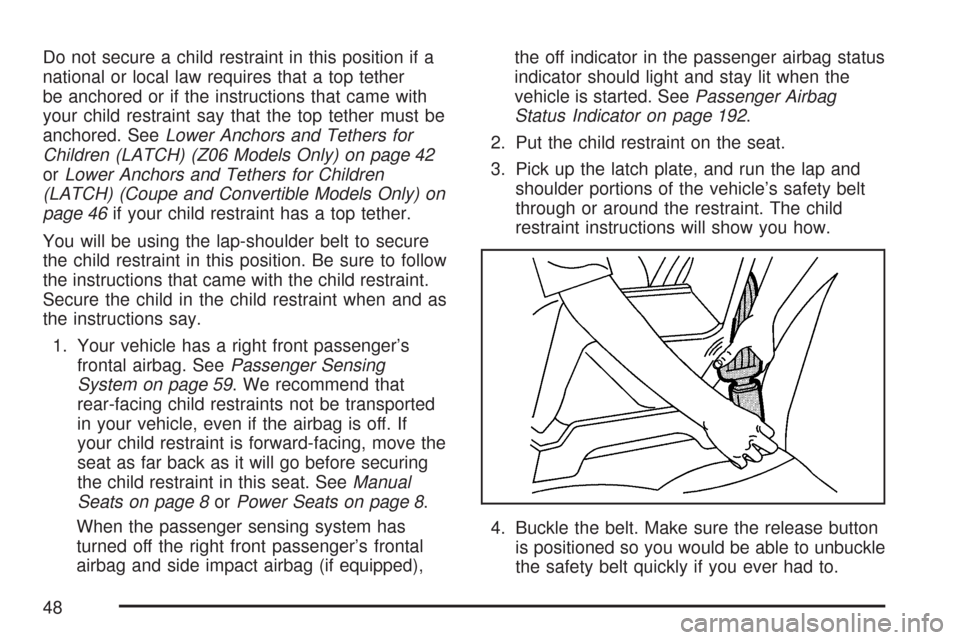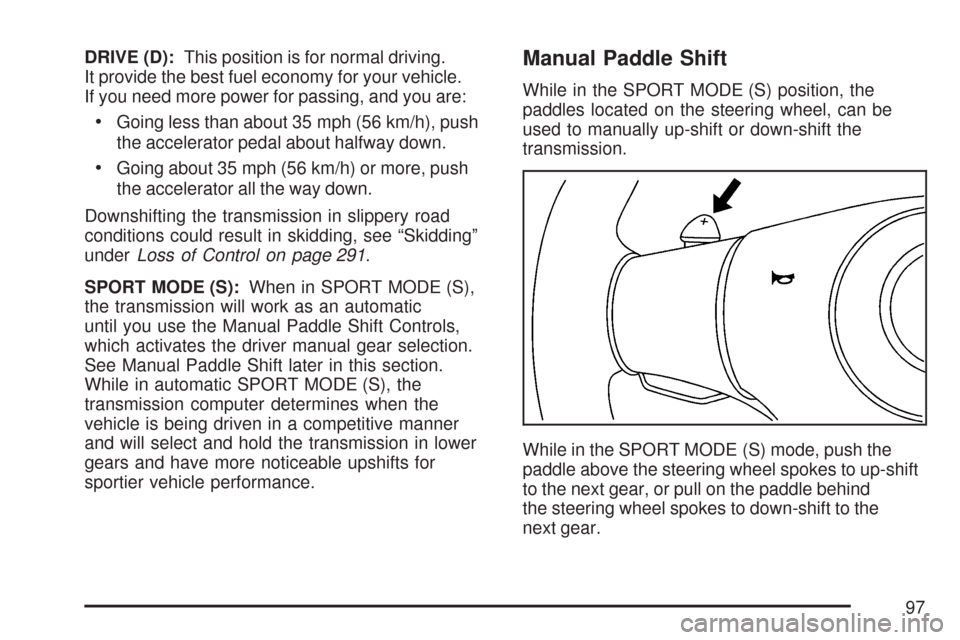2007 CHEVROLET CORVETTE sport mode
[x] Cancel search: sport modePage 48 of 488

Do not secure a child restraint in this position if a
national or local law requires that a top tether
be anchored or if the instructions that came with
your child restraint say that the top tether must be
anchored. SeeLower Anchors and Tethers for
Children (LATCH) (Z06 Models Only) on page 42
orLower Anchors and Tethers for Children
(LATCH) (Coupe and Convertible Models Only) on
page 46if your child restraint has a top tether.
You will be using the lap-shoulder belt to secure
the child restraint in this position. Be sure to follow
the instructions that came with the child restraint.
Secure the child in the child restraint when and as
the instructions say.
1. Your vehicle has a right front passenger’s
frontal airbag. SeePassenger Sensing
System on page 59. We recommend that
rear-facing child restraints not be transported
in your vehicle, even if the airbag is off. If
your child restraint is forward-facing, move the
seat as far back as it will go before securing
the child restraint in this seat. SeeManual
Seats on page 8orPower Seats on page 8.
When the passenger sensing system has
turned off the right front passenger’s frontal
airbag and side impact airbag (if equipped),the off indicator in the passenger airbag status
indicator should light and stay lit when the
vehicle is started. SeePassenger Airbag
Status Indicator on page 192.
2. Put the child restraint on the seat.
3. Pick up the latch plate, and run the lap and
shoulder portions of the vehicle’s safety belt
through or around the restraint. The child
restraint instructions will show you how.
4. Buckle the belt. Make sure the release button
is positioned so you would be able to unbuckle
the safety belt quickly if you ever had to.
48
Page 97 of 488

DRIVE (D):This position is for normal driving.
It provide the best fuel economy for your vehicle.
If you need more power for passing, and you are:
Going less than about 35 mph (56 km/h), push
the accelerator pedal about halfway down.
Going about 35 mph (56 km/h) or more, push
the accelerator all the way down.
Downshifting the transmission in slippery road
conditions could result in skidding, see “Skidding”
underLoss of Control on page 291.
SPORT MODE (S):When in SPORT MODE (S),
the transmission will work as an automatic
until you use the Manual Paddle Shift Controls,
which activates the driver manual gear selection.
See Manual Paddle Shift later in this section.
While in automatic SPORT MODE (S), the
transmission computer determines when the
vehicle is being driven in a competitive manner
and will select and hold the transmission in lower
gears and have more noticeable upshifts for
sportier vehicle performance.
Manual Paddle Shift
While in the SPORT MODE (S) position, the
paddles located on the steering wheel, can be
used to manually up-shift or down-shift the
transmission.
While in the SPORT MODE (S) mode, push the
paddle above the steering wheel spokes to up-shift
to the next gear, or pull on the paddle behind
the steering wheel spokes to down-shift to the
next gear.
97
Page 98 of 488

To use the system, shift from PARK (P) position
to SPORT MODE (S) while stopped and with the
engine running, or from DRIVE (D) with the vehicle
moving. When accelerating your vehicle from a stop
in snowy and icy conditions, you may want to shift
to second (2) or third (3) gear. A higher gear allows
you to gain more traction on slippery surfaces. If the
traction control is active, upshifts are delayed to
increase your control of the vehicle. SeeTraction
Control System (TCS) on page 281.
While the Manual Paddle Shift gear selection
system is active, the transmission will automatically
downshift through the gears as the vehicle slows.
The transmission will select second gear as the
vehicle stops. From a stop, the vehicle will start
from and hold second (2) gear unless the driver
manually paddle shifts into a different gear or
selects DRIVE (D). The driver can select �rst (1)
gear for maximum acceleration from a stop.When using the Manual
Paddle Shift Feature
while in the SPORT
MODE (S), the current
gear will be displayed in
the Driver Information
(DIC), or the Head-Up
Display (HUD), if the
vehicle has either of
these features.
If your vehicle has a Navigation system, see
“Head-Up Display (HUD)” in the Index of
the navigation manual.
The Manual Paddle Shift system will not allow
either an up-shift or a down-shift if the vehicle
speed is too fast or too slow, nor will it allow a
start from Fourth (4) or higher gear
If up-shifting does not occur when needed, the
vehicle speed will be limited to protect the engine.
The transmission will also automatically
down-shift as the vehicle slows down and
comes to a stop.
98
Page 232 of 488

If this message is displayed during normal vehicle
operation on �at roads, your vehicle may need
service. See your dealer for an inspection.
If driving in a performance or competitive manner,
the use of (S) Sport Automatic Mode or (S) Sport
Manual Paddle Shift gear selection is
recommended. SeeAutomatic Transmission
Operation on page 95for more information.
To acknowledge the message, press the RESET
button. The message reappears every 10 minutes
until this condition changes. If you do not press
the RESET button, the message remains on
the display until the condition changes.
TURN SIGNAL ON
This message displays and a chime sounds
if a turn signal is left on for three-quarters of
a mile (1.2 km). Move the turn signal/multifunction
lever to the off position.
To acknowledge this message, press the RESET
button.
UNLATCH HEADER TO MOVE TOP
This message displays and a chime sounds if you
try to lower the convertible top without �rst unlocking
the top. Move the latch handle to unlock the
convertible top. SeeConvertible Top (Manual) on
page 139orConvertible Top (Power) on page 146.
Other Messages
Here are more messages that you can receive
on your Driver Information Center (DIC). To
acknowledge a message and read another
message that may have come on at the same
time, press the RESET button.
ACCESSORY MODE ON
BATTERY VOLTAGE HIGH
SeeVoltmeter Gage on page 194.
BATTERY VOLTAGE LOW
SeeVoltmeter Gage on page 194.
CHECK WASHER FLUID
SeeWindshield Washer Fluid on page 360.
CRUISE SET TO XXX MPH (XXX km/h)
SeeCruise Control on page 164.
232
Page 247 of 488

XM™ Satellite Radio Service
If your vehicle has the XM™ satellite radio
service, it is based in the 48 contiguous United
States and Canada. XM™ offers a large variety of
coast-to-coast channels including music, news,
sports, talk, traffic/weather (U.S. subscribers), and
children’s programming. XM™ provides digital
quality audio and text information that includes
song title and artist name. A service fee is required
in order to receive the XM™ service. For more
information, contact XM™; In the U.S. at
www.xmradio.com or call 1-800-852-XMXM (9696)
or in Canada at www.xmradio.ca or call
1-877-GET-XMSR (438-9677).
Playing the Radio
Top Knob (Power/Volume):Press this knob to
turn the system on and off. Turn this knob
clockwise or counterclockwise to increase or
decrease the volume.
4(Information):For RDS, press the4button to
change what display while using RDS. The display
options are station name, RDS station frequency,
PTY, and the name of the program (if available).For XM™ (if equipped), press the information
button while in XM™ mode to retrieve four different
categories of information related to the current
song or channel: Artist, Song Title, Category
or PTY, Channel Number/Channel Name.
To change the default on the display, press the
4button until you see the desired display,
then hold the
4for two seconds. The radio
produces one beep and the selected display is
now the default.
AUTO
n(Automatic Volume):Automatic
volume automatically adjusts the audio system to
make up for road and wind noise as you drive,
by it increasing the volume as vehicle speed
increases.
Set the volume at the desired level. Press the
AUTO
nbutton to select AUTO VOLUME MIN
(minimum), AUTO VOLUME MED (medium),
or AUTO VOLUME MAX (maximum). Each higher
setting provides more volume compensation at
faster vehicle speeds. To turn automatic volume
off, press the AUTO
nuntil AUTO VOLUME
OFF displays.
247